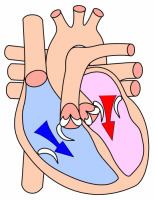 | ||
Diastole /daɪˈæstəliː/ is the part of the cardiac cycle when the heart refills with blood following systole (contraction). Ventricular diastole is the period during which the ventricles are filling and relaxing, while atrial diastole is the period during which the atria are relaxing. The term diastole originates from the Greek word διαστολη, meaning dilation. Diastole is closely related to the phenomenon of recoil within ballistics.
Contents
Role in cardiac cycle
During ventricular diastole, the pressure in the (left and right) ventricles drops from the peak that it reaches in systole. When the pressure in the left ventricle drops to below the pressure in the left atrium, the mitral valve opens, causing accumulated blood from the atrium to flow into the ventricle.
The ventricular filling velocity or flow into the ventricles have two main components; First an early (E) diastolic one caused ventricular suction, and second, a late one created by atrial contraction (A). The E/A ratio can be used as a diagnostic measure, since it is reduced in diastolic dysfunction.
Early diastole, i.e., the E-wave in the E/A ratio, is a suction mechanism. In late diastole, i.e., the A-wave, as the left and right atria contract, the blood pressure in each atrium increases, forcing additional blood into the ventricles. This is known as atrial kick. 80% of the blood flows passively down to the ventricles during the E-wave active suction period, so the atria do not have to contract a great amount.
Inside the arteries
The adjective "diastolic" is used to refer to filling of the heart with blood between muscle contractions. It is used to describe the opposite portion of the cardiac cycle related to contraction. More typically it is used as one component of measurement of blood pressure. "Diastolic pressure" refers to the lowest pressure within the arterial bloodstream occurring during each heartbeat. The other component of blood pressure is systolic pressure, which refers to the highest arterial pressure during each heartbeat.
Clinical notation
When blood pressure is stated for medical purposes, it is usually written as a seeming "ratio" of systolic to diastolic pressure; for example: 120/80 mmHg. This is not intended to be read as a ratio and for the vast majority of purposes cannot be legitimately read as a ratio. It is not a display of a numerator over a denominator but rather a medical notation used for quickly showing the two clinically significant pressures involved and cannot be reduced into lower terms.
Diagnostic value
Examining diastolic function during a cardiac stress test is a good way to test for heart failure with preserved ejection fraction.
Effects of impaired diastolic function
Brain natriuretic peptide (BNP) is a cardiac neurohormone secreted from ventricular myocytes at the end of diastole. Increased BNP concentrations have been found in patients who experience diastolic heart failure.
